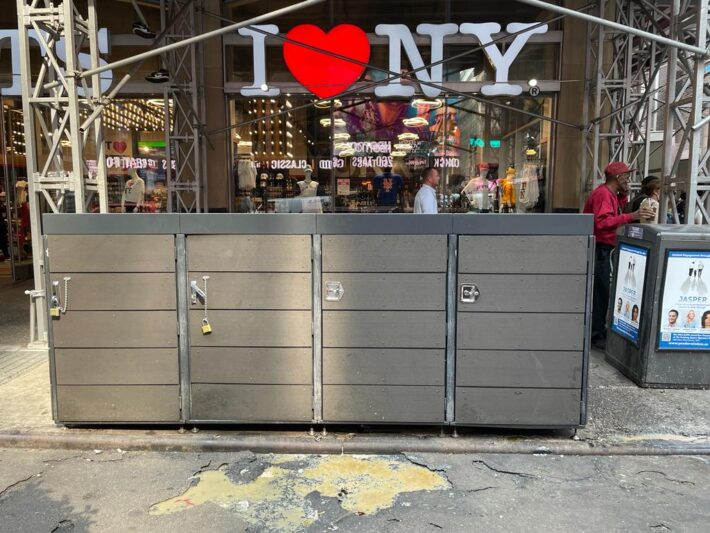
The waste collection bins lined up along streets in Times Square mark the first installation of Clean Curbs, the $1.3 million pilot program sponsored by the city’s sanitation department.
In 2016, former Mayor Bill de Blasio committed to a goal of achieving zero waste to landfills by 2030 to cut down greenhouse gas emissions. The plan would put an end to the common practice of dumping large amounts of garbage into areas of land zoned for contaminated waste. To achieve this mission, New York City has launched several initiatives and Clean Curbs is one of them.
The pilot program, which launched in April, includes new containerized trash bins on West 41st Street and 7th Avenue and West 43rd Street and 8th Avenue, while other zero waste efforts include drop off sites for food scraps that can be composted, including at curbside locations offered at the headquarters of Manhattan Community Boards 6 and 7. But Midtown residents and local environmentalists have mixed opinions on whether the trash pickup in Times Square is getting any better around the neighborhood or enough to have an impact.
Adjacent to the trash bins at West 41st Street and 7th Avenue, a mother and daughter duo sell clothes and other accessories on the street.
“Trash doesn’t overflow and pile-up like it used to before, so the bins have helped make the place a little bit cleaner,” said Melanie Pomerlee. “It’s helped the business too because people stop and shop when it’s clean.”
Pomerlee added that while it feels better to see the streets cleaner, trash remains an issue in New York City. “Some streets are still so filthy,” she said.
For Kyle Athayde, chair of Community Board 6, sanitation has been a huge priority.
“People don’t feel like the situation of waste is improving,” said Athayde. “When you walk around the city and you see trash leaking and you see mounds of bags, it doesn’t make you feel motivated that we are reaching that goal by 2030. It feels like the opposite.”
According to sanitation department data from January to June, Manhattan’s District 4, which includes Times Square, averages 122.4 tons of trash per day.
And trash complaints have increased over the years. In 2016, when the zero waste goal was introduced, New York City’s 311 portal received 843 trash-related complaints from Midtown residents. This year, there have been 1,726 complaints from local residents.
The Clean Curbs pilot program is supposed to get bags off the streets to reduce rat infestations and trash heaps, said Regina Fojas, senior vice president and chief of staff at Times Square Alliance, a non-profit that promotes tourism in the area.
“At the most basic level the Clean Curbs pilot program has achieved our need which is to keep garbage bags off the street or off of the sidewalk,” said Fojas. “Bins is not the ultimate solution but at least it’s better than just leaving bags where they are.”
In an effort to improve sanitation, the Times Square Alliance collects and removes about 95% of garbage from the area. “Right before the pandemic when there were budgetary cuts and the department of sanitation had rolled back its pickups and the overall routes, TSA’s sanitation team worked full time throughout the pandemic to keep the area clean,” said Fojas.
There are critics of the city’s zero waste by 2030 goal.
“We are nowhere near that,” said Eddie Bautista, executive director of the New York City Environmental Justice Alliance. “The De Blasio government was enthusiastic about rolling out ideas and policy recommendation goals, but if your implementation is not serious, if it’s not efficient, if it’s not driven from a sense of urgency or priority from City Hall, you can’t get anything done.”
A lack of financial support is one of the issues, said Bautista. “A way that zero waste goals get undermined is by inconsistent city funding for recycling and composting services.”
Another issue lies in the collection of both residential and commercial waste from different spots in New York city by private trucks, said Bautista. A majority of this waste gets trucked to low-income communities, including the South Bronx and South Queens, where it is then packed onto either waste transfer trucks or trains, he added.
“The way I kind of describe it is in 2022, we’re sending people to explore Mars and the solar system and the universe but we still throw trash on the side of the street and wait for it to be picked up,” said Athayde. “You know there’s no innovation when it comes to sanitation whatsoever.”
Note: *Data from 2022 monthly reports for DSNY curbside collections was averaged to calculate tons of trash. **311 service requests data for Midtown zip codes was calculated to arrive at number of complaints.